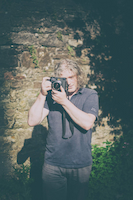Polarising filters, also known as polarisers or circular polarisers are essential filters in any photographer's kit.
Usually in the form of a screw-in filter, polarisers block out some polarised light allowing only light travelling in one direction to pass through the filter to reach the sensor.
Simply, we use polarisers for one reason - to reduce glare or reflected light from objects or subjects.
This has the effect of increasing saturation, particularly in the greens and blues - think of the sky and foliage; reducing reflections from shiny surfaces such as windows, wet surfaces, and glossy foliage.
Polarisers can reduce contrast and increase contrast in an image, it depends on the angle of light, the subject matter and how much of an effect the polariser is set to.
Polarising filters have a varying effect, by twisting the outer ring of the filter you can increase or decrease the effect. Circular polarisers are not called circular polarisers because they are circular, it's to do with the type of polarised light that they allow and restrict. Linear polarisers also exist, but these are incompatible with autofocus on SLR and mirrorless camera systems. Linear polarisers are effective on rangefinder cameras for instance.
As seen in the image here, of Dublin Castle's Bedford Tower the polariser has increased the saturation of the blue sky by reducing glare from dust and pollution in the atmosphere, it has also reduced some glare on the window and clock in particular, it has reduced contrast on the stonework adding to the details visible in the image. I think in this case, the polarised image looks best - how about you, do you prefer the polarised or non-polarised version?
Panoramic Ireland's photography tours and workshops cover topics such as using polarising filters, when to use them and when not to use them. Join us to learn more about photography and learn from our years of experience working for the biggest names in world publishing.



